Alix Mary Lacoste
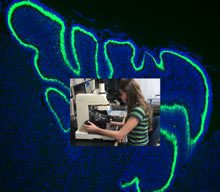
Growth factors are not traditionally known to play a role in cell migration. However, preliminary data suggest that insulin-like growth factor (Igf) functions in the guidance of granule cells within the cerebellum. The cerebellum is an important structure, responsible for the fine control of balance and movement and also involved in motor learning and memory. The cerebellar granule cell is the most abundant neuron in the brain, and investigating its development and wiring could provide insights into the functioning of the cerebellum and into diseases that affect its function. Using […]
Erik Petigura

Oxygen is the third most abundant element in the universe behind hydrogen and helium. However, measuring its abundance in stars is surprisingly difficult. This is because oxygen transition lines are weak, hard to model, or contaminated with other lines. Recently, new techniques for measuring the oxygen content from stellar spectra have been developed. I will apply these techniques to the nearest 1000 solar-type stars and measure their oxygen content. The oxygen content in stars plays an important role in planet formation. Specifically, the ratio of carbon to oxygen is critical […]
Wing Shing Yip
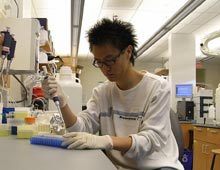
T. thermophilus RNase H (TthRNase H) is a protein that is stable at high temperatures. In my project, I will examine how the amino acid sequence of TthRNase H determines its folding properties that lead to its thermostability. To approach this question, I am going to construct two proteins, one containing the core of C. tepidum RNase H (a protein stable at moderate temperatures) and the periphery of TthRNase H and another containing the core of C. tepidum RNase H and the the periphery of E. coli RNase H (a […]
Jacob Harrison Levine
The current conception of the hormonal regulation of mammalian reproduction purports that the anterior pituitary gland and the peripheral sex organs are controlled by a hypothalamic releasing factor (Gonadotropin Releasing Hormone: GnRH) which acts on the pituitary. Recent research suggests that secretion of hypothalamic releasing factor is itself tightly regulated by neuropeptides that are novel to this line of research. One such peptide, kisspeptin, also known in cancer research as metastin for its role as a metastasis suppressor, has been shown to be a positive regulator of the reproductive axis, […]
Raymond Lam
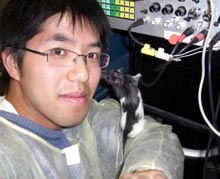
Neural Prosthetics is a newly emerging field with many potential applications for patients who have lost one of their five senses. At the core of this technology, electrical microstimulation of neurons is used to artificially generate and restore lost senses. For my project, I will be targeting the visual cortex, and developing a rodent visual model for microstimulation in order to explore stimulation patterns that mimic natural neural activity. The goal of this project is to develop a more safe and effective way to elicit visual response and perception in […]
Roxanne Rajaii
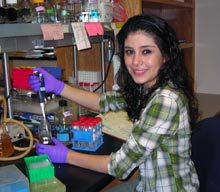
Cell responses are mediated by signal transduction pathways that involve protein and lipid kinase cascades. One of the two essential PtdIns 4-kinases in the budding yeast (S. cerevisiae), encoded by the PIK1 gene, localizes both to the Golgi and in the nucleus and has an essential function in both compartments. Pik1 in the Golgi functions in regulating secretion from the Golgi to the cell surface, but the processes that Pik1 helps regulate in the nucleus are not well understood. In an effort to understand the essential role of Pik1 in […]
Albert Yu

In the human body, the liver is the only organ that can regenerate following substantial damage. But if all cells contain the same genetic information, how is this function unique to the liver? This summer I will study regeneration in the wing imaginal discs of developing Drosophila larvae. My goal is to develop a system that introduces localized cell death in these discs. Following cell death, I will visualize the amount and location of cell proliferation in the remaining cells. With this system, I can assess the ability of mutant […]
Julia Elizabeth Himes
The blue ringed octopus (H. lunulata) is a highly toxic animal, secreting tetrodotoxin (TTX) as a means of defense and prey capture. H. lunulata is an important organism for studying toxicity and its role in behavior, evolution, and reef ecology. Today, these octopuses are taken from the wild for study, and few survive in captivity. The goal of this summer’s project is to design a method of rearing H. lunulata from egg to maturity. This is very difficult, as the paralarval hatchlings or this species are pelagic and require a […]
Abhiram Gande
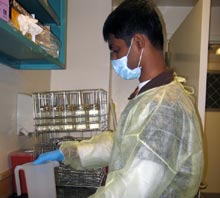
My research will focus on the effects of stress on neurogenesis (the birth of new neurons) in the dentate gyrus (DG) of the adult rat hippocampus. The hippocampus is essential for memory and learning function. Interestingly, chronic stress has been shown to decrease cell proliferation in the DG and reduce the effectiveness of hippocampuss memory function. My project will investigate one potential factor that may prevent stress-induced reduction of neurogenesis: controllability. Studies have shown that animals that can control the onset/offset of stress do not show many negative effects of […]
Hai Le

It is essential that the cell preserves the integrity of its DNA by initiating a proper response when there is damage to its genome. As a fellow of the Summer Undergraduate Research Fellowships, I am utilizing this summer and the senior academic year to study the DNA repair pathway in heterochromatin. Using Drosophila melanogaster as a model system, I propose to fluorescently tag different DNA repair proteins and conduct experiments to understand the kinetics of these proteins following DNA damage induced by X-ray treatment. This research is promising: knowledge of […]